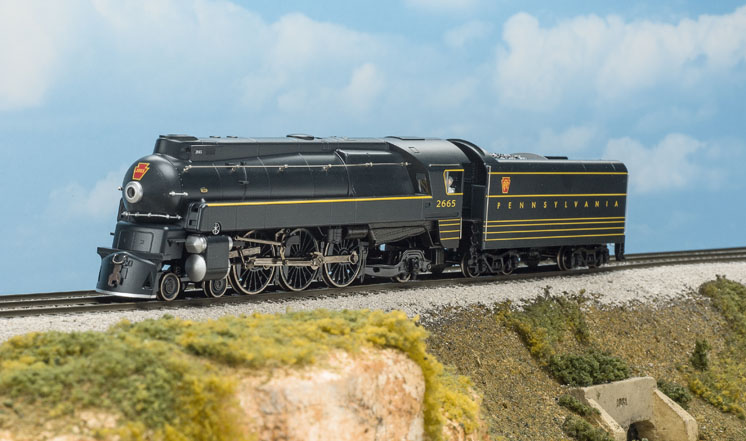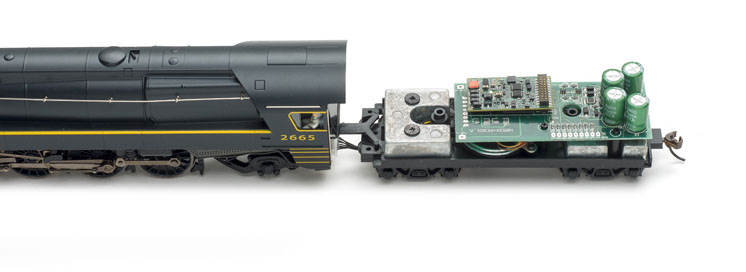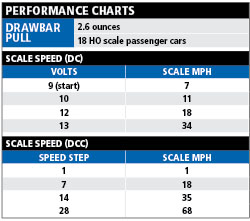While the Pennsylvania RR rostered thousands of steam locomotives, only a few of them, other than the duplex-drive T1s, ever got the streamlined treatment. Bachmann Trains is now offering the first HO scale plastic model of a K4s Pacific in the 1940 streamlining the Pennsy applied to four locomotives, complete with a Train Control Systems (TCS) WOWSteam dual-mode decoder.
The prototype. The K4s 4-6-2 Pacific is one of the iconic American steam locomotives. The PRR built 425 of them, 350 at the railroad’s Juniata shops in Altoona, Pa., the other 75 by Baldwin Locomotive Works in Philadelphia. The first, no. 1737, was built in 1914. After three years of testing, the remaining 424 were built between 1917 and 1928 in eight batches. The first streamlined K4, no. 3768 (also the Pennsy’s first streamliner), emerged in 1936. It was designed by longtime PRR collaborator Raymond Loewy. In 1940, four more streamlined K4s were produced, this time designed by Loewy associate C. Louis Otto.
When new, the K4s pulled all of the Pennsy’s name trains. The four 1940 streamlined locomotives, nos. 1120, 2665, 3678, and 5338, were commissioned to pull the South Wind, General, and Jeffersonian, as well as other trains, including the Broadway Limited. The design of their shrouds made routine maintenance points accessible, an advantage over the 1936 design.
As the years went by, the shrouding was removed. A 1947 photo in The Steam Liners by Kevin J. Holland (TLC Publishing, 2002) shows no. 5338 with its hemispherical nose cap removed and headlight in the traditional PRR location at the top front of the smokebox.
The K4s finished its career pulling New York City commuter trains to New Jersey shore points on the New York & Long Branch, a joint line with the Central RR of New Jersey. Two non-streamlined locomotives have been preserved – no. 1361, which was displayed at Horseshoe Curve, and no. 3750, at the Railroad Museum of Pennsylvania – but neither is in running condition.
The model. Bachmann’s model consists of a plastic boiler on a die-cast metal frame. The proportions of the boiler compare well to published photos of the streamlined locomotive. The handrails above the running boards are metal. Those on the front of the smokebox are silver painted plastic.
As the streamlined shroud covers most of the boiler, there’s little in the way of the typical mechanical bits of a steam locomotive. The bottom of the air compressor and firebox sides are separate parts. The air tanks and their piping are part of the firebox sides.
The cab includes two painted crew figures and a simplified backhead. A hinged cab apron bridges the gap between the cab and tender deck.
The streamlined tender has separate metal handrails, an illuminated backup light, and a metal uncoupling lever. A Bachmann E-Z Mate Mark II coupler is body-mounted at the correct height. Another E-Z Mate coupler is included for installation on the pilot if the owner chooses to doublehead the locomotive, a common PRR practice.
Most major dimensions on the model were within inches of drawings in the Model Railroader Cyclopedia – Vol. 1 Steam Locomotives (Kalmbach Media, 2010), with the exception of wheel diameters. The drivers on model are 76″ in diameter. The prototype’s were 80″.
The diameter of the pilot wheels is 31″ instead of 36″ as on the prototype, and the trailing wheels are 42″ diameter instead of 50″. The driver center-to-center spacing matches published dimensions. The tender trucks have 36″ diameter wheels as on the prototype.
The Dark Green Locomotive Enamel, also known as Brunswick Green, is evenly applied and appears to be in the range of shades vehemently argued over by Pennsy fans.
The striping and lettering match published photos, although the cab number looks a little heavy. Also, in this era, PRR passenger locomotives were decorated with gold-leaf striping and lettering, rather than the yellow of the model.
Inside the tender is a downward-facing speaker between two die-cast metal weights that support a TCS motherboard with the firm’s Keep-Alive capacitor circuit. The Keep-Alive helps the locomotive negotiate dirty track and other power interruptions. Atop the motherboard is the WOWSteam decoder and a surface-mount light-emitting diode (LED) for the backup light.
I removed the tender shell to connect the engine and tender together. This is simple enough, but there are two things to watch out for. I removed the forward screw by turning the truck to one side to get around the pickup wiper. On the rear truck, I removed the front wheelset, then the wiper to access the tender screw.
Don’t be tempted to remove the trucks. There are small nuts inside, and the rear one is under the motherboard, which you’ll have to remove to replace the nut.
Inside the locomotive is a flywheel-equipped can motor, which sends power to the rear driver through a gear tower. The other drivers are powered through the side rods. A die-cast metal weight adds heft. The headlight plus an orange flickering firebox glow in the cab are illuminated by LEDs.
On the test track. I started testing with Digital Command Control (DCC) using an NCE PowerCab. The locomotive started moving in speed step 1 at 1 scale mph, great for gently coupling to a passenger train. Top speed was 68 scale mph, a little slow on an engine that could touch 100 mph on the flatlands leading into Chicago, but plenty fast enough for most model railroads.
With power to the track, the TCS WOWSteam decoder reproduced the sounds of a simmering steam locomotive, then commenced four chuffs per revolution of the drivers as I advanced the throttle. Turning on the headlight triggered the generator sound, function button 1 sounded the bell, and F2 and F3 were assigned to the whistle, either latching (F2) or a short toot (F3).
Double-clicking F8 caused the decoder to cycle through three pages of sound and motor effects. Page 3, for example, has a grade crossing quill at F0, which makes it easy to replicate the distinctive sounds engineers could produce with a steam whistle.
Direct current (DC) testing was a little less satisfying. The locomotive ran fine with a Bachmann no. 44211 power pack, but all other DC power sources in our workshop, even using a TCS DC filter, created issues of one kind or another.
With the Bachmann pack, the locomotive started moving at 7 scale mph at 9V, giving two toots on its whistle before moving out with its bell ringing. The bell continues until about 12V, or 18 scale mph. A quick twist of the power pack’s throttle produced a grade crossing sequence. The top speed I recorded was 34 scale mph at the power pack’s maximum voltage, 13V.
Once I was done in the workshop, I took Bachmann’s streamlined K4s to our staff layout, the Milwaukee, Racine & Troy, for further testing. Looking for appropriate-era passenger cars, I found seven likely suspects and coupled them to the tender of the Bachmann K4s.
The locomotive pulled off with no problem through the level station at Milwaukee and continued on through Marquette Yard.
Climbing the 1.5 percent grade out of the yard started the wheels slipping, but after I removed two cars from the train, the engine climbed the hill with five cars. Hard-to-reach areas with notoriously dirty rails were no obstacle for the Keep-Alive-equipped decoder. Going down the 5 percent grade of the connecting track behind the staging yards, the strong chuff realistically faded to simulate the locomotive drifting downhill.
The steamer tracked perfectly through the no. 6 turnouts of Bay Junction Yard, whether crawling slowly or rushing through.
Bachmann’s streamlined K4s is a fine addition to its steam locomotive line. The addition of TCS’s WOWSteam decoder increases the excitement level of any steam locomotive, and the streamlined treatment helps it stand out even further. Whether you’re a Pennsy fan or a steam fan, this streamlined K4s would make a fine addition to your roster.
Manufacturer
Bachmann Trains
1400 E. Erie Ave.
Philadelphia, PA 19124
www.bachmanntrains.com
Era: 1940 to circa 1947
Road numbers: 2665, 1120, 3678, 5338
Features
• Audio Assist programming tool for sound-assisted decoder customization
• Blackened metal wheels and siderods
• Die-cast metal chassis
• E-Z Mate Mark II couplers, front and rear at correct height
• Keep-Alive capacitor device for uninterrupted sound and power
• Operating LED headlight and backup light with dimming
• Painted engineer and fireman figures
• Performs best on 22″ radius curves or greater
• TCS WOWSteam dual-mode decoder
• Weight: 1 pound, 1.7 ounces (engine and tender); 13.1 ounces (engine alone)

















It looks like a very nice model, but I wish Bachmann would offer it, and many of their other models, in a straight DC or DCC-Ready version. I run DC and I’m also on a budget, so $469 is much more than I can afford.